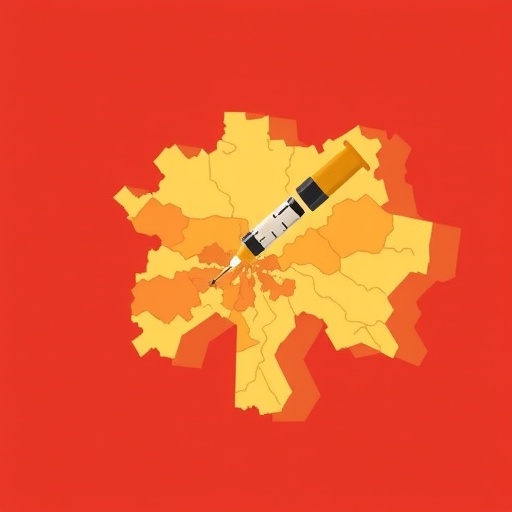In a groundbreaking study published in Nature Communications, researchers have unveiled how the timing and coverage of measles vaccination critically influence the trajectory toward near elimination of the disease. Utilizing sophisticated mathematical modeling, the team revealed intricate dynamics that challenge conventional vaccination strategies and open a new frontier in infectious disease control. This work not only underscores the importance of strategic immunization schedules but also provides policymakers with analytical tools to optimize intervention efforts in the race against measles.
Measles, once a ubiquitous childhood illness, has been relentless in its capacity to cause devastating outbreaks despite decades of vaccination efforts. The virus’s extreme contagiousness means that even small lapses in vaccination coverage can ignite sizable epidemics. The new mathematical framework developed by Suffel and colleagues captures these complex interactions by simulating scenarios reflecting varied coverage and vaccination timing, providing a high-resolution lens through which to predict disease trends.
The study’s model integrates epidemiological parameters with population dynamics, simulating near-elimination contexts where measles persists in low numbers or as occasional outbreaks. What sets this model apart is its capacity to assess not only how much vaccination coverage is achieved but how the timing of vaccine administration — whether during infancy, childhood, or catch-up campaigns — shapes the overall transmission dynamics over time.
A pivotal finding of the analysis revealed that achieving high coverage alone may not be sufficient in pushing measles to the brink of eradication. If vaccination schedules do not align carefully with demographic and social mixing patterns, the timing gaps can create vulnerable cohorts that maintain chains of transmission, resulting in periodic flare-ups. The model highlights that strategically shifting vaccination timing to target these susceptible pockets can manipulate the epidemic curve in significant ways.
The researchers also elucidate the concept of “transmission potential windows,” periods during which the virus can exploit immunity gaps in the population. These temporal windows emerge from natural birth rates, seasonal behavior changes, and waning immunity, illustrating the fragile balance between herd immunity and outbreak risk. Optimizing vaccination to close these windows could prove key to suppressing persistent measles transmission clusters.
Importantly, the mathematical model incorporates stochastic effects — acknowledging the element of chance that can either extinguish or sustain residual measles infections in near-elimination settings. This feature is crucial since random events can heavily influence measles persistence when case numbers are minimal, a nuance often overlooked in deterministic models.
One unexpected insight is the identification of a counterintuitive scenario where accelerating vaccination timing without sufficiently high coverage could paradoxically elevate outbreak risk. This occurs because prematurely vaccinating individuals before optimal immune response development might increase the proportion of partially protected individuals who remain susceptible over time, making timing decisions more delicate than previously understood.
The study further confirms that catch-up vaccination campaigns hold immense value in sealing immunity gaps in populations where routine coverage stagnates. However, their effectiveness depends sensitively on when they are implemented relative to the epidemic cycle, reinforcing the call for data-driven timing strategies rather than fixed schedules.
These findings have profound implications for global measles eradication efforts. While vaccination coverage targets are widely established, the nuanced role of timing demands a reassessment of public health priorities. Equipping health authorities with models that forecast epidemic outcomes based on varied deployment scenarios allows adaptive immunization campaigns that respond dynamically to local epidemiological signals.
Another practical takeaway concerns resource allocation. By quantifying how marginal improvements in timing can achieve outsized reductions in cases, policymakers can optimize vaccine delivery schedules to maximize impact while potentially reducing costs. This is particularly relevant for low- and middle-income countries where vaccination programs face logistical constraints.
The study also frames future research directions. Extending these models to incorporate spatial heterogeneity, interaction with other vaccines, and behavioral factors could generate even more precise guidance. Moreover, integrating real-time surveillance data into such modeling frameworks could enable rapid adjustments in vaccination strategies as outbreaks evolve.
Beyond measles, the modeling approach showcased here holds promise for other vaccine-preventable diseases that hover near elimination thresholds. Understanding how timing and coverage interplay to shape pathogen dynamics might inform strategies against outbreaks of diseases like rubella, polio, or pertussis.
The research team emphasizes collaboration between epidemiologists, modelers, and public health officials to translate these theoretical insights into actionable policies. By bridging the gap between mathematical abstraction and field implementation, the findings could catalyze a new era of precision vaccination.
As the world persists in the fight against measles, this study shines a spotlight on an often-overlooked aspect of immunization strategy: not just who gets vaccinated, but when. With measles still causing tens of thousands of deaths annually, refining vaccination schedules in light of these findings could provide the final push toward the disease’s near eradication.
The study ultimately redefines our understanding of vaccination impact, showing that timing, much like coverage, is a critical lever in infectious disease control. The elegant fusion of mathematical modeling and epidemiological insight framed in this work transforms abstract theory into tangible paths forward, rekindling hope for global measles elimination.
As public health systems digest these insights, the global community moves closer to a future where measles, a once fearsome foe, becomes a memory etched in history. Precision in timing may well be the secret weapon in closing the chapter on this devastating disease, unlocking a world where measles is no longer a threat.
Subject of Research: Impact of vaccination timing and coverage on measles elimination dynamics
Article Title: Impact of vaccination timing and coverage on measles near elimination dynamics: a mathematical modelling analysis
Article References:
Suffel, A.M., Warren-Gash, C., McDonald, H.I. et al. Impact of vaccination timing and coverage on measles near elimination dynamics: a mathematical modelling analysis. Nat Commun 16, 8601 (2025). https://doi.org/10.1038/s41467-025-63710-w
Image Credits: AI Generated




